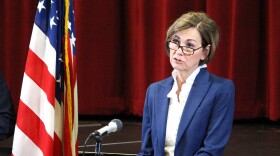School leaders have been waiting for these details since Gov. Kim Reynolds told them about two weeks ago that state law requires the majority of school instruction to be in-person, even as the coronavirus continues to spread in Iowa. This came after some school districts were already planning to start the school year with majority or fully online classes.
For a school to get a waiver to hold more than half its classes online under the new guidance released Thursday, the entire county must test positive for coronavirus at an average rate of 15 percent over two weeks, and at least 10 percent of students must be absent.
Even if a school or district meets these benchmarks, the state could reject its request to move to all online learning.
Iowa Public Radio asked Reynolds why the threshold is 15 percent when health authorities have said communities should see less than 10 percent, 5 percent or 3 percent positivity to safely return to in-person learning.
“We feel that’s adequate for in-school learning,” Reynolds said.
Dr. Eli Perencevich, an internal medicine and epidemiology professor at the University of Iowa, said the 15 percent threshold for distance learning is three to five times higher than what public health researchers have recommended.
And he disagrees with the state characterizing up to 6-14 percent positivity as “minimal to moderate” community transmission of the virus.
“That would be extensive community transmission,” Dr. Perencevich said. “At that level, most public health authorities would want us to really increase social distancing, not open schools, close down bars and restaurants, [and] mandate masks.”
Dr. Perencevich said a Harvard and MIT collaboration determined it’s safe to reopen schools if residents are testing positive for coronavirus at a rate of 3 percent or less, but the goal should really be 1 percent.
He added the state should also consider the number of new cases each day per 100,000 population when evaluating if it’s safe to return to in-person learning.
According to The Washington Post, CDC Director Robert Redfield said there should be exceptions to in-person learning in virus “hot spots.” Asked to define a hot spot, Redfield told reporters those are places with 5 percent or more positivity. According to Iowa’s coronavirus information website, the statewide positivity rate was 8.6 percent on Wednesday.
The U.S. Surgeon General said communities with less than 10% positivity should go back to in-person learning. Reynolds mentioned that and said 93 of Iowa’s 99 counties are under 10 percent.
Iowa State Education Association President Mike Beranek said the association representing teachers “rejects” the “outlandish” threshold for distance learning and will promote its own requirements.
“We will continue to listen to world health experts, scientists and specialists who tell us that counties with extensive testing should be at a positivity rate of 5 percent or lower before it’s safe to reopen schools,” Beranek said in a statement.
Dr. Perencevich said while children are less likely to get severe symptoms of COVID-19, adults who work in schools or older family members at home might get the virus from kids.
He said while early studies seemed to suggest children don’t transmit the virus as much as adults, the evidence has evolved.
“Children, especially over the age of 10, are just as likely [as adults] to acquire the virus and spread the virus,” Dr. Perencevich said. “Under 10 the data is still emerging, but it appears that young kids can have really high viral loads and also spread, but we need more data in the smaller kids.”
As for schools’ potential for driving community spread of the coronavirus, Dr. Perencevich points to a new study that found spring school closures were associated with about a 60% reduction in infections.
He said state leaders should require masks and close bars to get virus transmission down to a level
“You have to earn it to open colleges and schools,” Dr. Perencevich said. “You can’t just hope. And right now, our public health strategy seems more based on hope and less on science.”
Reynolds also defended the state’s lack of a mask mandate after multiple health and physician groups wrote to her advocating for a mask requirement.
“I believe that Iowans are doing the right thing,” Reynolds said. “I’m doing it through a PR campaign, ‘step up, mask up.’”
She said states with a mask mandate aren’t necessarily enforcing it and some still have increasing virus numbers.
The state also announced Thursday it would start enforcing social distancing requirements at bars and restaurants, with penalties ranging from fines to license revocations.
Reynolds said she will go back to holding two coronavirus-related news conferences each week.




